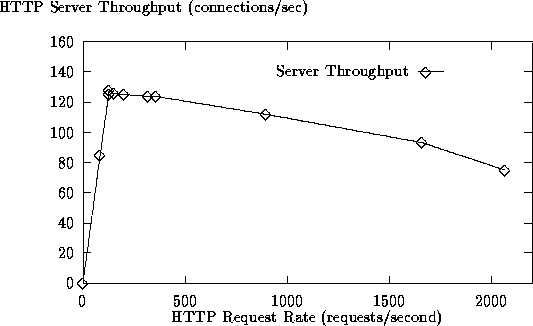

Being able to reliably generate high request rates, we used the new method to evaluate how a typical commercial Web server behaves under high load. We measured the HTTP throughput achieved by the server in terms of transactions per second. The same 1294 byte file as before was used in this test.
Figure 7: Web server throughput versus request rate
Figure 7 plots the server throughput versus the total connection request rate. As before, the server saturates at about 130 transactions per second. As we increase the request rate beyond the capacity of the server, the server throughput declines, initially somewhat slowly, and then more rapidly reaching about 75 transactions/second at 2065 requests/second. This fall in throughput with increasing request rate is due to the CPU resources spent on protocol processing for incoming requests (SYN packets) that are eventually dropped due to the backlog on the listen socket (the full accept queue).
The slope of the throughput drop corresponds to about 325 usec worth of processing time per SYN packet. While this may seem large, it is consistent with our observation of the performance of a server system based on a 4.4BSD network subsystem retrofitted into SunOS 4.1.3_U1 on the same hardware.
This large drop in throughput of an overloaded server highlights the importance of evaluating the overload behavior of a Web server. Note that it is impossible to evaluate this aspect of Web server performance with current bench marks that are based on the simple scheme for request generation.